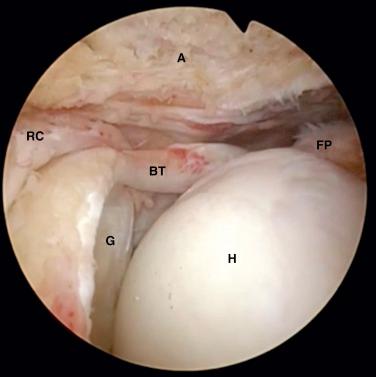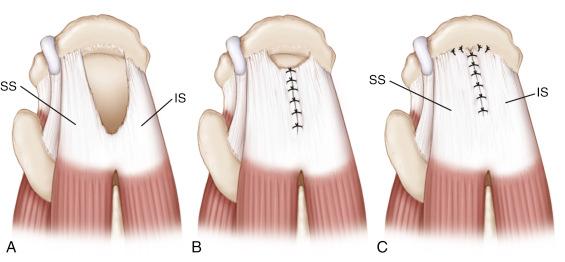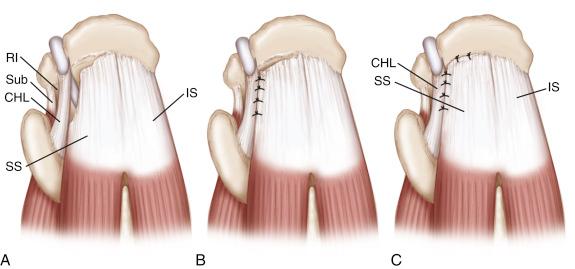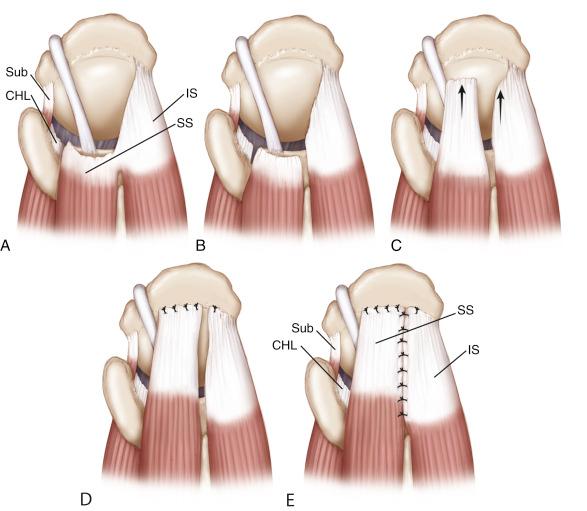Physical Address
304 North Cardinal St.
Dorchester Center, MA 02124
Rotator cuff tears are classically described as crescent-shaped, U-shaped, L-shaped, reverse L-shaped, and massive contracted immobile tears. Tear pattern recognition is critical to ensuring anatomic repair of the rotator cuff, restoring and balancing the force couples about the shoulder, and reestablishing a normal glenohumeral fulcrum of motion. Crescent-shaped tears have excellent medial-to-lateral mobility and can be repaired directly to bone. U- and L-shaped tears require side-to-side sutures prior to tendon-to-bone fixation. Massive contracted rotator cuff tears are more technically challenging, often requiring extensive soft-tissue releases to achieve a tension-free repair to bone. These releases may include an intracapsular (or intraarticular) release, anterior or posterior interval slides, and releases specifically for the subscapularis tendon.
Following diagnostic arthroscopy, a bursal resection is performed, exposing the tear margins. The mobility of the tendon is assessed, and the tear pattern is established. If a full-thickness subscapularis tear is present, this is addressed first by identifying the “comma sign” and performing subscapularis releases and repair. Although most posterosuperior tears can be repaired with standard mobilization techniques (i.e., bursal resection, intracapsular release) and by understanding the tear pattern, interval slides (e.g., a posterior interval slide, anterior interval slide, interval slide in continuity, or combination) may be used to obtain a tension-free repair in massive contracted immobile tears.
A 57-year-old right-hand-dominant man with a 3-year history of chronic shoulder pain developed acute increase in pain following a sudden heavy lift at work.
Persistent pain and weakness following a 3-month trial of conservative management.
He complains of difficulty with reaching, pushing-pulling, and behind-the-back activities and inability to perform overhead activities.
Full passive range of motion, excessive passive external rotation
Unable to actively abduct beyond 90 degrees (pseudoparalysis)
Positive impingement signs (i.e., Neer and Hawkins-Kennedy tests)
Positive infraspinatus test results (i.e., external rotation lag test)
Positive subscapularis test results (i.e., belly press, lift-off tests)
Positive biceps provocative test results (i.e., Speed and Yergason tests)
Standard radiographs are obtained, including anteroposterior, transscapular lateral, and axillary views. These images are used to rule out fracture, dislocation, and arthritic changes.
Evidence of chronic cuff insufficiency is assessed, including evidence of proximal humeral migration, acetabulization of the acromion, and femoralization of the humeral head. These findings may indicate chronic rotator cuff arthropathy with an irreparable cuff despite advanced releases.
Magnetic resonance imaging (MRI) or a magnetic resonance arthrogram will assist in the identification of the tendons involved. The degree of muscle atrophy, fatty infiltration, and retraction should be assessed ( Fig. 16.1 ).

Muscles that demonstrate significant muscular atrophy and/or fatty infiltration (above grade III) are more likely to provide insufficient tendon excursion (despite releases) to provide a robust repair with clinical improvement in strength.
Physical therapy (3-month home exercise program)
Weeks 0–6: stretching exercises to decrease pain and increase range of motion
Weeks 7–12: maintain range of motion and integrate resistance exercises to improve strength and muscular control
Medications (analgesics, antiinflammatories)
Subacromial bursal injections (e.g., cortisone)
Arthroscopic debridement with or without biceps tenotomy
Arthroscopic rotator cuff repair with advanced releases
Open rotator cuff repair or tendon transfer salvage procedures (pectoralis major tendon transfer, latissimus dorsi transfer)
Humeral head
Rotator cuff ( Fig. 16.2 )

Acromion
Biceps tendon
Rotator cuff footprint
General indications for rotator cuff repair: Persistent pain or weakness despite a trial of conservative treatment including a formal physical therapy program for 3 months. (Note: urgent treatment is considered when a clear acute onset of injury is described.)
Patient factors (i.e., age and symptomatology) are carefully considered preoperatively. Although there is a trend toward reverse total shoulder arthroplasty for elderly patients with massive “irreparable” rotator cuff tears, interval slides remain a viable option for younger patients seeking improved function and reduced pain.
Radiographic evidence of proximal migration of the humeral head with acromial acetabulization and humeral head femoralization precludes interval slide releases. The degree of tendon retraction, muscular atrophy, and fatty infiltration seen on MRI scans should also be considered.
Interval slides are performed when poor mobility is demonstrated in both the anteroposterior and mediolateral planes despite bursal and intraarticular releases.
Subscapularis releases are performed for contracted full-thickness subscapularis tears to improve mobility and achieve a tension-free repair.
Lateral decubitus position
Patient’s trunk is supported by beanbag with pillows between legs.
Arm is placed in longitudinal traction (approximately 10 lb) using a Tenet Spider limb positioner with lateral arm attachment (Smith & Nephew, Andover, MA).
Careful attention is paid to padding all boney prominences outside the surgical field.
Position the patient as far up the table as possible, allowing improved ergonomics and circumferential access to the shoulder.
The operative shoulder should be tilted slightly posterior to position the glenoid parallel to the floor and allow for easy glenohumeral joint distraction.
Beanbag must be placed high enough to support the patient’s trunk and scapula but without obstructing access to the shoulder.
Lateral positioning allows for optimal positioning and translation of the arm in order to maximize visualization for releases and repair.
Patient is placed too low on the operating table, limiting working space around the shoulder.
Excessive traction from the limb positioner can translate the shoulder anteriorly and risks neurologic injury.
Beanbag placement ineffectively controls the trunk or obstructs access to the shoulder.
Standard arthroscopic equipment (i.e., pump, suction, shaver, burr)
30-degree and 70-degree arthroscopes
Ambient Super Turbovac 90 (Smith & Nephew)
Arthroscopic scissors (Arthrex, Inc, Naples, FL)
Tenet Spider limb positioner with lateral arm attachment (Smith & Nephew)
Posterior portal (main viewing portal)
Lateral portal (working portal for rotator cuff repair, intracapsular release, posterior interval slide)
Anterosuperolateral portal (working portal for subscapularis releases)
Accessory lateral portals (intracapsular release, anterior interval slide, posterior interval slide)
Modified Neviaser portal (traction suture retrieval during intracapsular release)
Accessory percutaneous anchor portals (as needed for repair)
A standard posterior glenohumeral portal is established, and a diagnostic scope is performed. The margins of the tear are exposed. If a subscapularis tear is identified, an anterosuperolateral portal is established first, and the subscapularis is released and repaired. The subacromial space is then entered, and the posterosuperior rotator cuff is then approached. A grasper is used through the lateral portal to assess tendon mobility in an anteroposterior and mediolateral direction. The tear pattern is defined, and the repair technique is established. Crescent-shaped tears have excellent medial-to-lateral mobility and can be repaired directly to the rotator cuff footprint. U- and L-shaped tears have reduced medial-to-lateral mobility but good anterior-to-posterior mobility. Side-to-side sutures may be required prior to tendon fixation to bone to achieve a tension-free repair. Massive rotator cuff tears have poor medial-to-lateral and anterior-to-posterior mobility and may require extensive soft-tissue releases ( , Figs. 16.3–16.5 )



Video 16.1: Subscapularis soft tissue releases (anterior, superior, posterior) and tendon mobilization.
Become a Clinical Tree membership for Full access and enjoy Unlimited articles
If you are a member. Log in here